|
Having just published our 2019 Top 50 List By Customer Orders, I started thinking about which albums from the year I found most amazing, and which I returned to multiple times during the year. The number listed is an odd one, 18, but they were the albums that came to mind as I considered this list, and really, what's in a number?
This list is substantially different from our sales list, but I suppose it represents my personal quirks and interests, that which fuels me as we plan our catalog for the year. In fact, more than a couple of these have been non-starters on the store, always a sad fate for a deserving album; I won't tell you which weren't as well received as I believed they should be. Nor will I tell you which were well received but might not have made the top 50. As I write the abstracts for each album as they're added to our Recently Released section, most of what needs to be known will be in the original listing. However, I will in most cases elaborate as an addendum my own personal interest in each.

Andersen, Arild / Clive Bell / Mark Wastell
Tales Of Hackney
(Confront)
World instrumentation of shakuhachi, thai flute, shinobue, thai mouth organ, and shruti box blends with western orchestration of double bass, percussion and electronics as Clive Bell, Arild Andersen, and Mark Wastell come together in the studio after their well-received concert at Cafe Oto in London to develop these beautifully lyrical improvisations.
addendum I found myself returning to this album repeatedly as I introduced the album to our store for two reasons: one, it insinuates itself to its listeners by appearing to be a more conventional jazz album and then envelops them in a dream-like world. Wastell never fails to mesmerize me, and with Clive Bell and Arild Andersen the three use their eclectic instrumentation to create something other-worldly, at times familiar, and at times as exotic as one could imagine.

Bauer, Matthias
Spontan In Granit
(Creative Sources)
Berlin double bassist Mathias Bauer, a member of Unitedberlin, Asian Art, Junge Music and mosaik, and half of the duo Alchimia Organica, presents a series of 18 solid and diverse spontaneous improvisations, most averaging under 3 minutes, captivating the listener through articulate momentum, exceptional technique, and inventive narrative.
addendum: I have become quite interested in solo performance albums over the years, which are certainly the most daring of presentations, and the most naked. I'm also an enthusiast of concise statement, and Bauer gives his listeners a succinct set of unique recordings, taking the bass into unusual territory and revealing a curious and exploratory mind.

Rodrigues / Leblanc / Lopes
Montreal
(Creative Sources)
Named for the city in which it was recorded, the trio of Karoline Leblanc on harpsichord, Ernesto Rodrigues on viola, and Paulo J Ferreira Lopes on gongs & cymbals, is a mysterious and ritualistic album, Lopes' gongs slowly intoning as the strings use unusual techniques, much of the harpsichord played inside; a subtle and beautiful reflection of historic Montreal.
addendum: In 2003 I took a chance on a Portuguese label that had sent me several review CDs to consider: Creative Sources. I was under the spell of so-called lowercase or Onkyo music at the time, and found the work of violist Ernesto Rodrigues and his then small group of similar-minded colleagues exceptional. The label now has more than 600 titles, justifying my decision through an ever-evolving set of releases with an ever-expanding number of musicians, many of which would otherwise be unknown to me. All that aside, whenever Rodrigues, and now his son, cellist Guilherme Rodrigues, release an album that they perform on I'm eager and interested. Montreal did not disappoint, a perfect example of why I return to Rodrigues' work regularly. The album is a single 57 minute work, the trio using restraint, and subtle extended techniques and reverberant ambience to enfold the listener, with subtle field recordings extending the music. Having been to Montreal many times, I draw the sense of a quiet morning in the historic district, and each motion and gesture feels appropriate and focused. Turn the volume up and give the music your attention, the rewards are found in this trio's finesse.
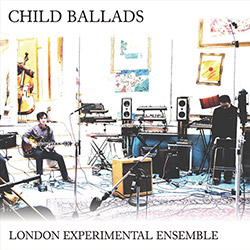
London Experimental Ensemble
Child Ballads
(Split Rock Records)
Drawn from 305 traditional ballads from England and Scotland alongside their American variants, anthologised by Francis James Child during the second half of the nineteenth century, are here sung by Ed Pettersen in the fascinating intersection of traditional lyrics and experimental interpretations of melodies, performed by the 11-piece London Experimental Ensemble.
addendum: The name of this album may be deceptive, as it refers to Francis James Child, and not to children's songs. Child anthologized traditional ballads, and the London Experimental Ensemble draws from these to create modern and, well, more experimental versions of those songs. I have returned to this album many times, spurred by the ensemble's exceptional Treatise album interpreting the music of Cornelius Cardew. I am also reminded of Lindsay Cooper's exceptional Rags album as I hear history reflected and morphed through modern ears and interpretations.

Wooley, Nate (Wooley / Sawyer / Halvorson / Alcorn)
Columbia Icefield
(Northern Spy)
With two guitarists--Mary Halvorson and Susan Alcorn on pedal steel--and Ryan Sawyer on drums, New York trumpeter explores the Rocky Mountains Columbia Icefield, the largest icefield in the Canadian Rocky Mountains, through sophisticated compositions and superbly illustrative sound, an exceptional album of improvisation and intention from four modern masters.
addendum: There are three albums with trumpeter Nate Wooley in this list, and there's no doubt I'm a dedicated fan of his work. What I find most interesting is how unpredictable each release from him is, from creative modern improvisation (jazz) to conceptual experimental works, to work with sounds, or driven by twisted theory. His accomplices in this work are extraordinary players of our time, and he brings out the best in his performers as they seem to do to him. Columbia Icefield is a perfect example of what I find fascinating in his work, as his quartet with guitarists Mary Halvorson and Susan Alcorn, and drummer Ryan Sawyer, interpret a massive Canadian icefield in sound. If that sounds "cold", you'll be surprised at how well the concept brings that sense of vast area to life, over three long-form compositions using electronics in specific ways that complement the otherwise acoustic orchestration. "Seven in the Woods" brings the album together for me, in beautiful solos and group interaction that surprises in approach, as the piece shifts focus while maintaining location.
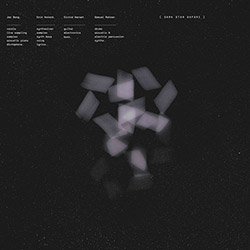
Dark Star Safari (Rohrer / Bang / Honore / Aarse)
Dark Star Safari
(Arjunamusic)
Percussionist Samuel Rohrer invited Jan Bang and Eivind Aarset to his Berlin studio to record the 10 improvisations that create the basis for these haunting songs, the band taking that material to enhance and shape resulting compositions, inspiring Jan Bang to develop the lyrics reminiscent of David Sylvian's recent work, resulting in this darkly impressive album.
addendum: The description in my abstract might say enough about this wonderfully dark and compelling album. I had no idea Jan Bang had this aspect of expressive lyricism and vocal skill, which has drawn me back to this album many times.

I Am Three & Me (Nicols, Maggie / Silke Eberhard / Nikolaus Neuser / Christian Marien)
Mingus' Sounds Of Love
(Leo Records)
Following their 2016 album "I Am Three, Mingus, Mingus, Mingus", the German trio of Silke Eberhard on alto saxophone, Nikolaus Neuser on trumpet, and Christian Marien on drums invited British improvising vocalist Maggie Nicols to further explore the works of jazz legend Charles Mingus in song and spoken word in a thoroughly enjoyable and worthy tribute to his work.
addendum: I feel like all I should have to write is "Mingus" to explain this release, but no doubt there's a tremendous amount of his work interpreted already. What distinguishes this for me is Maggie Nicols, who joins saxophonist Silke Eberhard, trumpeter Nikolaus Neuser, and drummer Christian Marien, as they take a really quirky and loving take on the late composer and bassist's music. This is the 2nd release for the trio, the first four years prior, and the compatibility and seamlessness of their playing is remarkable. I get a kick out of the trio being bass-less, but somehow that's fitting for their approach to his music. Great tracks include "Weird Nightmare", "Haitian Fight Song" and "The Clown", the last read superbly by Nicols. And the strangest is Mingus' description of how to toilet train a cat. Quirky probably doesn't do justice to the album and the way the music and voice work together, but through irreverence the band shows reverence to one of the greatest jazz composers of the last century.
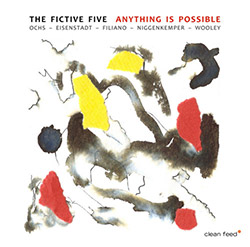
Fictive Five, The (Ochs / Wooley / Filiano / Niggenkemper / Eisenstadt)
Anything Is Possible
(Clean Feed)
A tour-de-force of modern creative jazz from the quintet of Larry Ochs on tenor & sopranino saxophones, Nate Wooley on trumpet, Ken Filiano on bass & effects, Pascal Niggenkemper on bass & effects, and Harris Eisenstadt on drums, the familiar history of the musicians and the staggering skill of each bearing out the album's title, in 2 collective and 3 Ochs compositions.
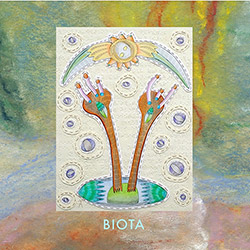
Biota
Fragment For Balance
(Recommended Records)
From Mnemonist Orchestra to Biota, with 18 albums in total, the Colorado collective Biota presents its 11th album on ReR, taking 4 years to complete this genre-defying album of gorgeous abstraction through free improvisation and composition, absorbing styles and reflecting them in a filtered ray of melody & song using unusual instrumentation and arrangment; absolutely recommended
addendum: In April I wrote a description of this album, which continues to be heard in my house with great frequency. From that I explained: This album includes a 32 page full color booklet with artwork, credits and track listings. The artwork includes paintings, drawings, collages and photographs, most of them abstract and in keeping with the band's approach, varying bright colorful images with dark vaguely threatening ones, alongside impressionistic curiosities. It's a beautiful accompaniment to the music, part of a profoundly interesting package of music, words and image.

Fire! Orchestra
Arrival
(Rune Grammofon)
Trimmed back to a mere 14 musicians, the Fire! Orchestra core trio of Mats Gustafsson, Johan Berthling, and Andreas Werliin and Orchestra original singers Mariam Wallentin and Sofia Jernberg add a string quartet, expanding their palette as they release their warmest and most embraceable album to date, from original material to covers of Robbie Basho and Chic.
addendum: Fire! has been releasing albums at a steady pace for a number of years, in large and smaller formats, from septet to orchestra, with guests including Jim O'Rourke and Oren Ambarchi. The core of the band is Mats Gustafsson (reeds), Johan Berthling (bass), and Andreas Werliin (drums & percussion), with a healthy dose of electronics used in decisive ways. This album is a return to the Fire! Orchestra, which has been as large as 28 musicians, but here is "trimmed back" to 14 musicians. What I find so enjoyable with this release is two-part: first, this rarely feels like an orchestra to me, so perfectly controlled is the orchestration that the music often feels more skeletal, which makes the swelling of power and expression so impressive when everyone joins in. The second is in the choice of material, an eclectic set of popular songs interpreted in profoundly interesting ways. Personal favorites include Robbie Basho's "Blue Crystal Fire" and Chic's "At Last I Am Free", where vocalists Mariam Wallentin and Sofia Jernberg bend the songs to their will in deeply emotional ways. This album has been in heavy rotation on my car stereo since it arrived.
![CARL (Damon Smith / Daniel Kamins / Andrew Durham):Solid Bottom [CASSETTE w/ DOWNLOAD] (Astral Spirits)](http://www.teuthida.com/productImages/misc4/27912.jpg)
CARL (Damon Smith / Daniel Kamins / Andrew Durham)
Solid Bottom [CASSETTE w/ DOWNLOAD]
(Astral Spirits)
Two basses and a lower-end saxophone from the trio of Damon Smith on double bass, Andrew Durham on electric bass, and Danny Kamins on baritone sax, Durham also adding effects and "Radio Manipulation" to their deep sound, Durham & Kamins the core of CARL with Damon Smith adding extra underpinnings to their slowly developing, sometimes pensive, sometimes cantankerous, profound improvisation.
addendum: The Astral Spirits label has introduced me to a number of Chicago and West Coast players that I wasn't familiar with, and this album extends my familiarity with bassists Damon Smith and Andrew Durham by baritone saxophonist Danny Kamins. What draws me back to this, aside from my great regard for all things Damon Smith, is the exploratory and experimental nature of their work. Three deep sonic improvisers on a challengingly rewarding journey, what's not to love?

Parker, Evan / Matthew Wright / Trance Map+
Crepuscule in Nickelsdorf
(Intakt)
Composed by saxophonist Evan Parker and electronic artist Matthew Right, "Trance Map" has Parker triggering interactions with samples from Wright's record collection, reshaped by live processing, here in an incredible expanded performance at Konfrontationen 2017 with Adam Linson on bass & electronics, John Coxon on turntable & electronics, and Ashley Wales on electronics.
addendum: This is the last addendum I've written for this list (obviously written out of sequence). I wasn't originally going to say anything more about the album because, well, look at the players, some of the finest ea- and non-idiomatic improvisers on the London scene reworking their 2017 album. But it would have turned out to be the only album without an addendum reference, and it doesn't deserve that. How do these musicians continue to elate my ears year after year, untiringly progressing and expanding on their previous work? Amazing.
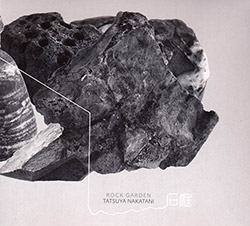
Nakatani, Tatsuya
Rock Garden
(Nakatani-Kobo)
Twelve percussion solos from incomparable Japanese percussionist living in Consequence, New Mexico, Tatsuya Nakatani, a dramatic presentation starting with bowed and resonant cymbals and developing into active sections of intense drumming using bowls and found objects to create complex and unique percussive environments filled with detail, mystery and excitement.
addendum: Having hosted Nakatani for several concerts here in Wilmington, I continue to be floored not only by his jaw-dropping technique on drums and percussive devices, but more importantly, by the drama and suspense he brings to his music. To get the entire album one must pick up the CD and cassette, which extends the CD with additional material, and I recommend both.
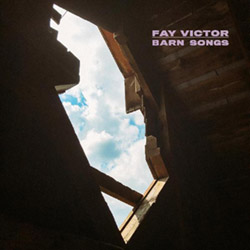
Victor, Fay
Barn Songs
(Northern Spy)
With cellist Marika Hughes (2 Foot Yard, Anthony Braxton's Trillum) and saxophonist Darius Jones (Little Women, Darius Jones Trio), vocalist Fay Victor introduces her Fay Victor Chamber Trio, the open instrumental foundation highlighting Victor's expressive songs and insightful lyric content, developed with Victor and Jochem van Dijk; a great example of creative contemporary jazz song.
addendum: I love the history of female jazz vocalists — Billy Holiday, Ella, Sarah — but it's rare that I find a modern vocalist that I can disassociate from that history. I suppose that's why I tend to the fully free vocalists like Shelley Hirsch, Joane Hétu, Maja Ratkje, DB Boyko, Ute Wasserman, &c. I've known Fay Victor's work mostly through her association with Thollem McDonas, William Parker, Nicole Mitchell, Anthony Braxton, and Other Dimensions in Music. After her Wet Robots album I was eager to get Barn Songs in stock, particularly as the trio format with bass and saxophone appeals to me, and especially with Darius Jones on alto sax. Fay is singing the words of Jochem van Dijk, insightful and observational, sometimes sassy, sometime exposed; all three make something delicate and profound of them, but it's Fay who leads the listener and keeps them engaged. It's by far my favorite "conventional" jazz vocal album of the year, and probably the past few years.

Wooley, Nate
Battle Pieces 4
(Relative Pitch)
"Battle Pieces" uses trumpeter Nate Wooley's "social music" system, where each piece is constructed for a soloist who improvises with no score while the remaining player choose at will from over 75 compositions over which the soloist must find their path; here at Roulette in NYC with Nate Wooley, Sylvie Courvoisier, Ingrid Laubrock, & Matt Moran.
addendum: The 3rd Battle Pieces is titles the 4th... somehow appropriate for the distinct approach to improvisation that Nate Wooley has developed for this series. With a set of absolutely impressive improvisers, Wooley allows one player complete freedom while the rest do battle with that player by selecting from a set of compositions that the soloist must find their own path through. It sounds daunting, but in the hands of masterful players, the results are fascinating. So much of the late 20th and 21st century improvisation has been dedicated to finding new ways to challenge players to find new ways and reason to express themselves. Wooley's approach reminds me of other Downtown NY game pieces, but with an approach that blends structure with freedom in a completely unique way. Absolutely impressive.
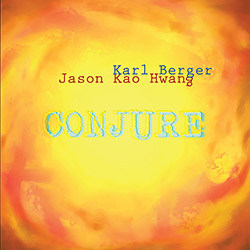
Berger, Karl / Jason Kao Hwang
Conjure
(True Sound Recordings)
Subtle, beautiful, haunting, masterful and delicately commanding, the duo of pianist and vibraphonist Karl Berger and Jason Kao Hwang on violin and viola recorded these 8 dialogs in Berger's Woodstock studio, their familiarity from Hwang's participation in Berger's Creative Music Orchestra summoning lyrical and sensitive music, finding profundity in restraint.
addendum: I was familiar with violinist Jason Kao Hwang's work mostly as a sideman when he approached us about a year ago to carry some of his solo work. Much of that has been active and sophisticated work (Blood, Sing House), complex in nature as his compositions blend Western and Eastern influences. Conjure is something quite different, a gorgeous album of beautiful dialog. Berger is an expressive player on both vibes and piano, and together he and Hwang find a source of warm camaraderie and passionate conversation, making a stunningly appealing album that for me is perfect for late night listening.
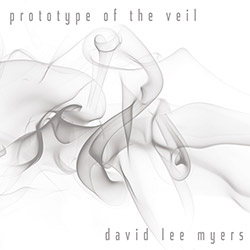
Myers, David Lee
Prototype Of The Veil
(pulsewidth)
David Lee Myers began creating feedback music in 1989, originally under the name Arcane Device, developing unique approaches to harnessing feedback between audio devices in ways their manufactures did not intend; since 2014 he has used a set of new devices that allow intense control and beauty through vibrational interactions, as heard in this, his 18th solo album of feedback music.
continued...
|



